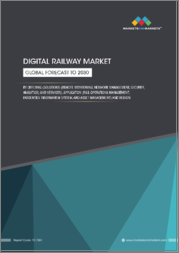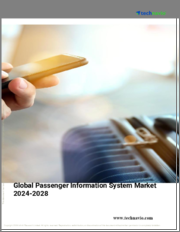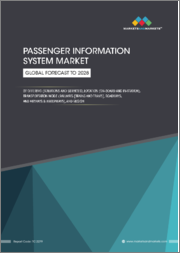
|
시장보고서
상품코드
1642698
항공 여객 통신 시스템 시장 보고서 : 컴포넌트, 항공기, 유통 채널, 지역별(2025-2033년)Airline Passenger Communications System Market Report by Component, Aircraft, Distribution Channel, and Region 2025-2033 |
||||||
세계의 항공 여객 통신 시스템의 시장 규모는 2024년에 65억 달러에 달했습니다. 향후 IMARC Group은 2033년에는 112억 달러에 달하며, 2025-2033년의 성장률(CAGR)은 6.2%에 달할 것으로 예측하고 있습니다. 기내 엔터테인먼트와 커넥티비티에 대한 수요의 증가, 소비자의 지출 능력 상승, 광범위한 연구개발(R&D) 활동이 시장을 촉진하는 주요 요인의 하나입니다.
항공 여객 통신 시스템(APCS)은 항공 승객이 비행 중 지상, 다른 승객 및 승무원과 연결 상태를 유지할 수 있도록 하는 컴포넌트 및 하위 시스템을 포함합니다. 여기에는 위성 통신 시스템, 지상 통신 네트워크, 서버, 중계기, 안테나, 수신기, 라우터 및 기타 장비가 포함됩니다. 이 시스템을 통해 승객과 항공사는 위성 및 지상 통신 네트워크를 통해 지상과 통신할 수 있으며, APCS는 승객에게 엔터테인먼트 컨텐츠, 기내 판매 및 서비스, 향상된 커뮤니케이션에 대한 액세스를 제공하기 위해 널리 사용되고 있습니다. 또한 항공편 상황 업데이트, 날씨, 목적지 정보 등의 정보도 제공합니다. 그 결과 APCS는 우주선, 군용기, 헬리콥터, 민간 항공기 등에 널리 사용되고 있습니다.
항공 여객 통신 시스템 시장 동향 :
기내 엔터테인먼트 및 연결성에 대한 수요 증가는 시장 성장을 가속하는 주요 요인 중 하나이며, APCS를 통해 승객은 비행 중에 영화, TV 프로그램, 음악, 게임과 같은 엔터테인먼트 컨텐츠에 액세스할 수 있습니다. 이에 따라 APCS가 항공편 상황, 지연, 게이트 변경 및 기타 중요한 정보에 대한 최신 정보를 제공하기 위해 널리 사용되고 있는 것이 시장 성장을 가속하고 있습니다. 또한 APCS를 통해 실시간으로 항공편에 대한 최신 정보를 제공함으로써 항공사 승객이 항상 연락을 유지할 수 있게 됨에 따라 커뮤니케이션 개선에 대한 수요가 증가하고 있는 것도 성장을 가속하는 요인으로 작용하고 있습니다. 이와는 별도로 가상현실과 증강현실(VR/AR) 기술을 통합하여 승객에게 새로운 몰입형 엔터테인먼트 경험을 제공하는 것이 시장 성장에 탄력을 받고 있습니다. 또한 APCS의 광범위한 사용은 항공 여행과 관련된 스트레스와 지루함을 줄이는 데 도움이 되는 커뮤니케이션 및 엔터테인먼트 서비스에 대한 액세스를 제공함으로써 승객의 전반적인 경험을 향상시켜 시장 성장에 긍정적인 영향을 미치고 있습니다. 또한 인공지능(AI)과 머신러닝(ML)을 활용하여 시스템의 성능과 능력을 향상시키는 등 다양한 기술 발전이 시장 성장을 크게 촉진하고 있습니다. 소비자의 지출 능력 증가, 항공 여행 증가, 항공 산업의 괄목할 만한 성장, 연구개발(R&D) 활동 강화, 성능 및 안전 강화를 위해 항공기에 첨단 시스템을 통합하는 기술 변화와 같은 다른 요인들도 시장 성장의 원동력이 될 것으로 예상됩니다.
이 보고서에서 다룬 주요 질문
- 전 세계 항공 여객 통신 시스템 시장 규모는?
- 2025-2033년 세계 항공 여객 통신 시스템 시장의 예상 성장률은?
- 세계 항공 여객 통신 시스템 시장을 주도하는 주요 요인은?
- COVID-19가 세계 항공 여객 통신 시스템 시장에 미치는 영향은?
- 전 세계 항공 여객 통신 시스템 시장의 항공기 기반 분석은?
- 세계 항공 여객 통신 시스템 시장의 주요 지역은?
- 세계 항공 여객 통신 시스템 시장의 주요 기업은?
목차
제1장 서문
제2장 조사 범위와 조사 방법
- 조사의 목적
- 이해관계자
- 데이터 소스
- 1차 정보
- 2차 정보
- 시장 추정
- 보텀업 어프로치
- 톱다운 어프로치
- 조사 방법
제3장 개요
제4장 서론
- 개요
- 주요 업계 동향
제5장 세계의 항공 여객 통신 시스템 시장
- 시장 개요
- 시장 실적
- COVID-19의 영향
- 시장 예측
제6장 시장 내역 : 컴포넌트별
- 트랜스폰더
- 시장 동향
- 시장 예측
- 디스플레이
- 시장 동향
- 시장 예측
- 안테나
- 시장 동향
- 시장 예측
- 수신기
- 시장 동향
- 시장 예측
- 기타
- 시장 동향
- 시장 예측
제7장 시장 내역 : 항공기별
- 우주선
- 시장 동향
- 시장 예측
- 군용기
- 시장 동향
- 시장 예측
- 헬리콥터
- 시장 동향
- 시장 예측
- 민간 항공기
- 시장 동향
- 시장 예측
제8장 시장 내역 : 유통 채널별
- 제조업체
- 시장 동향
- 시장 예측
- 애프터마켓
- 시장 동향
- 시장 예측
제9장 시장 내역 : 지역별
- 북미
- 미국
- 캐나다
- 아시아태평양
- 중국
- 일본
- 인도
- 한국
- 호주
- 인도네시아
- 기타
- 유럽
- 독일
- 프랑스
- 영국
- 이탈리아
- 스페인
- 러시아
- 기타
- 라틴아메리카
- 브라질
- 멕시코
- 기타
- 중동 및 아프리카
- 시장 동향
- 시장 내역 : 국가별
- 시장 예측
제10장 촉진요인·억제요인·기회
- 개요
- 촉진요인
- 억제요인
- 기회
제11장 밸류체인 분석
제12장 Porter's Five Forces 분석
- 개요
- 바이어의 교섭력
- 공급 기업의 교섭력
- 경쟁의 정도
- 신규 진출업체의 위협
- 대체품의 위협
제13장 가격 분석
제14장 경쟁 구도
- 시장 구조
- 주요 기업
- 주요 기업의 개요
- Airbus SE
- Collins Aerospace(Raytheon Technologies Corp.)
- Gogo Business Aviation LLC
- Honeywell International Inc.
- Panasonic Avionics Corporation
- Thales Group
- Wipro Limited
The global airline passenger communications system market size reached USD 6.5 Billion in 2024. Looking forward, IMARC Group expects the market to reach USD 11.2 Billion by 2033, exhibiting a growth rate (CAGR) of 6.2% during 2025-2033. The increasing demand for in-flight entertainment and connectivity, rising expenditure capacities of consumers, and extensive research and development (R&D) activities are some of the key factors driving the market.
An airline passenger communications system (APCS) includes the components and sub-systems that allow airline passengers to stay connected with the ground, with other passengers and crew members during their flight. It includes satellite communications systems, ground-based communications networks, servers, transponders, antennas, receivers, routers, and other equipment. The system allows passengers and airlines to communicate with the ground via satellite and ground-based communications networks. APCS is widely used to provide passengers with access to entertainment content, in-flight sales and services, and improved communication. It also provides information, including flight status updates, weather, and destination information. As a result, APCS is extensively used in spacecraft, military aircraft, helicopters, and commercial aircraft.
Airline Passenger Communications System Market Trends:
The increasing demand for in-flight entertainment and connectivity is one of the key factors driving the market growth. APCS allows passengers to access entertainment content during their flight that includes movies, TV shows, music, and games. In line with this, the widespread utilization of APCS to provide updates on flight status, delays, gate changes, and other important information is favoring the market growth. Moreover, the rising demand for improved communication as APCS allows airline passengers to stay connected by providing real-time flight updates, which in turn is acting as a growth-inducing factor. Apart from this, the integration of virtual and augmented reality (VR/ AR) technologies to provide passengers with new and immersive entertainment experiences is providing an impetus to the market growth. Furthermore, the widespread utilization of APCS to improve the overall passenger experience by providing access to communication and entertainment services that help to reduce the stress and boredom often associated with air travel is positively influencing the market growth. Additionally, various technological advancements, such as the utilization of artificial intelligence (AI) and machine learning (ML) to improve the system's performance and capabilities, are providing a considerable boost to the market growth. Other factors, including the rising expenditure capacities of consumers, increasing air travel, significant growth in the aviation industry, enhanced research and development (R&D) activities, and technological shift to integrate advanced systems into aircraft for performance and safety enhancement, are anticipated to drive the market toward growth.
Key Market Segmentation:
Component Insights:
- Transponder
- Display
- Antenna
- Receiver
- Others
Aircraft Insights:
- Spacecraft
- Military Aircraft
- Helicopters
- Commercial Aircraft
Distribution Channel Insights:
- OEM
- Aftermarket
Regional Insights:
- North America
- United States
- Canada
- Asia Pacific
- China
- Japan
- India
- South Korea
- Australia
- Indonesia
- Others
- Europe
- Germany
- France
- United Kingdom
- Italy
- Spain
- Russia
- Others
- Latin America
- Brazil
- Mexico
- Others
- Middle East and Africa
- The report has also provided a comprehensive analysis of all the major regional markets, which include North America (the United States and Canada); Europe (Germany, France, the United Kingdom, Italy, Spain, Russia, and others); Asia Pacific (China, Japan, India, South Korea, Australia, Indonesia, and others); Latin America (Brazil, Mexico, and others); and the Middle East and Africa. According to the report, North America was the largest market for airline passenger communications system. Some of the factors driving the North America airline passenger communications system market included rising expenditure capacities of consumers, significant growth in the aviation industry, and rapid technological advancements.
Competitive Landscape:
- The report has also provided a comprehensive analysis of the competitive landscape in the global airline passenger communications system market. Detailed profiles of all major companies have also been provided. Some of the companies covered include Airbus SE, Collins Aerospace (Raytheon Technologies Corp.), Gogo Business Aviation LLC, Honeywell International Inc., Panasonic Avionics Corporation, Thales Group, Wipro Limited, etc. Kindly note that this only represents a partial list of companies, and the complete list has been provided in the report.
Key Questions Answered in This Report
- 1. How big is the global airline passenger communications system market?
- 2. What is the expected growth rate of the global airline passenger communications system market during 2025-2033?
- 3. What are the key factors driving the global airline passenger communications system market?
- 4. What has been the impact of COVID-19 on the global airline passenger communications system market?
- 5. What is the breakup of the global airline passenger communications system market based on the aircraft?
- 6. What are the key regions in the global airline passenger communications system market?
- 7. Who are the key players/companies in the global airline passenger communications system market?
Table of Contents
1 Preface
2 Scope and Methodology
- 2.1 Objectives of the Study
- 2.2 Stakeholders
- 2.3 Data Sources
- 2.3.1 Primary Sources
- 2.3.2 Secondary Sources
- 2.4 Market Estimation
- 2.4.1 Bottom-Up Approach
- 2.4.2 Top-Down Approach
- 2.5 Forecasting Methodology
3 Executive Summary
4 Introduction
- 4.1 Overview
- 4.2 Key Industry Trends
5 Global Airline Passenger Communications System Market
- 5.1 Market Overview
- 5.2 Market Performance
- 5.3 Impact of COVID-19
- 5.4 Market Forecast
6 Market Breakup by Component
- 6.1 Transponder
- 6.1.1 Market Trends
- 6.1.2 Market Forecast
- 6.2 Display
- 6.2.1 Market Trends
- 6.2.2 Market Forecast
- 6.3 Antenna
- 6.3.1 Market Trends
- 6.3.2 Market Forecast
- 6.4 Receiver
- 6.4.1 Market Trends
- 6.4.2 Market Forecast
- 6.5 Others
- 6.5.1 Market Trends
- 6.5.2 Market Forecast
7 Market Breakup by Aircraft
- 7.1 Spacecraft
- 7.1.1 Market Trends
- 7.1.2 Market Forecast
- 7.2 Military Aircraft
- 7.2.1 Market Trends
- 7.2.2 Market Forecast
- 7.3 Helicopters
- 7.3.1 Market Trends
- 7.3.2 Market Forecast
- 7.4 Commercial Aircraft
- 7.4.1 Market Trends
- 7.4.2 Market Forecast
8 Market Breakup by Distribution Channel
- 8.1 OEM
- 8.1.1 Market Trends
- 8.1.2 Market Forecast
- 8.2 Aftermarket
- 8.2.1 Market Trends
- 8.2.2 Market Forecast
9 Market Breakup by Region
- 9.1 North America
- 9.1.1 United States
- 9.1.1.1 Market Trends
- 9.1.1.2 Market Forecast
- 9.1.2 Canada
- 9.1.2.1 Market Trends
- 9.1.2.2 Market Forecast
- 9.1.1 United States
- 9.2 Asia-Pacific
- 9.2.1 China
- 9.2.1.1 Market Trends
- 9.2.1.2 Market Forecast
- 9.2.2 Japan
- 9.2.2.1 Market Trends
- 9.2.2.2 Market Forecast
- 9.2.3 India
- 9.2.3.1 Market Trends
- 9.2.3.2 Market Forecast
- 9.2.4 South Korea
- 9.2.4.1 Market Trends
- 9.2.4.2 Market Forecast
- 9.2.5 Australia
- 9.2.5.1 Market Trends
- 9.2.5.2 Market Forecast
- 9.2.6 Indonesia
- 9.2.6.1 Market Trends
- 9.2.6.2 Market Forecast
- 9.2.7 Others
- 9.2.7.1 Market Trends
- 9.2.7.2 Market Forecast
- 9.2.1 China
- 9.3 Europe
- 9.3.1 Germany
- 9.3.1.1 Market Trends
- 9.3.1.2 Market Forecast
- 9.3.2 France
- 9.3.2.1 Market Trends
- 9.3.2.2 Market Forecast
- 9.3.3 United Kingdom
- 9.3.3.1 Market Trends
- 9.3.3.2 Market Forecast
- 9.3.4 Italy
- 9.3.4.1 Market Trends
- 9.3.4.2 Market Forecast
- 9.3.5 Spain
- 9.3.5.1 Market Trends
- 9.3.5.2 Market Forecast
- 9.3.6 Russia
- 9.3.6.1 Market Trends
- 9.3.6.2 Market Forecast
- 9.3.7 Others
- 9.3.7.1 Market Trends
- 9.3.7.2 Market Forecast
- 9.3.1 Germany
- 9.4 Latin America
- 9.4.1 Brazil
- 9.4.1.1 Market Trends
- 9.4.1.2 Market Forecast
- 9.4.2 Mexico
- 9.4.2.1 Market Trends
- 9.4.2.2 Market Forecast
- 9.4.3 Others
- 9.4.3.1 Market Trends
- 9.4.3.2 Market Forecast
- 9.4.1 Brazil
- 9.5 Middle East and Africa
- 9.5.1 Market Trends
- 9.5.2 Market Breakup by Country
- 9.5.3 Market Forecast
10 Drivers, Restraints, and Opportunities
- 10.1 Overview
- 10.2 Drivers
- 10.3 Restraints
- 10.4 Opportunities
11 Value Chain Analysis
12 Porters Five Forces Analysis
- 12.1 Overview
- 12.2 Bargaining Power of Buyers
- 12.3 Bargaining Power of Suppliers
- 12.4 Degree of Competition
- 12.5 Threat of New Entrants
- 12.6 Threat of Substitutes
13 Price Analysis
14 Competitive Landscape
- 14.1 Market Structure
- 14.2 Key Players
- 14.3 Profiles of Key Players
- 14.3.1 Airbus SE
- 14.3.1.1 Company Overview
- 14.3.1.2 Product Portfolio
- 14.3.1.3 Financials
- 14.3.1.4 SWOT Analysis
- 14.3.2 Collins Aerospace (Raytheon Technologies Corp.)
- 14.3.2.1 Company Overview
- 14.3.2.2 Product Portfolio
- 14.3.3 Gogo Business Aviation LLC
- 14.3.3.1 Company Overview
- 14.3.3.2 Product Portfolio
- 14.3.4 Honeywell International Inc.
- 14.3.4.1 Company Overview
- 14.3.4.2 Product Portfolio
- 14.3.4.3 Financials
- 14.3.4.4 SWOT Analysis
- 14.3.5 Panasonic Avionics Corporation
- 14.3.5.1 Company Overview
- 14.3.5.2 Product Portfolio
- 14.3.6 Thales Group
- 14.3.6.1 Company Overview
- 14.3.6.2 Product Portfolio
- 14.3.6.3 Financials
- 14.3.6.4 SWOT Analysis
- 14.3.7 Wipro Limited
- 14.3.7.1 Company Overview
- 14.3.7.2 Product Portfolio
- 14.3.7.3 Financials
- 14.3.1 Airbus SE
Kindly note that this only represents a partial list of companies, and the complete list has been provided in the report.



















